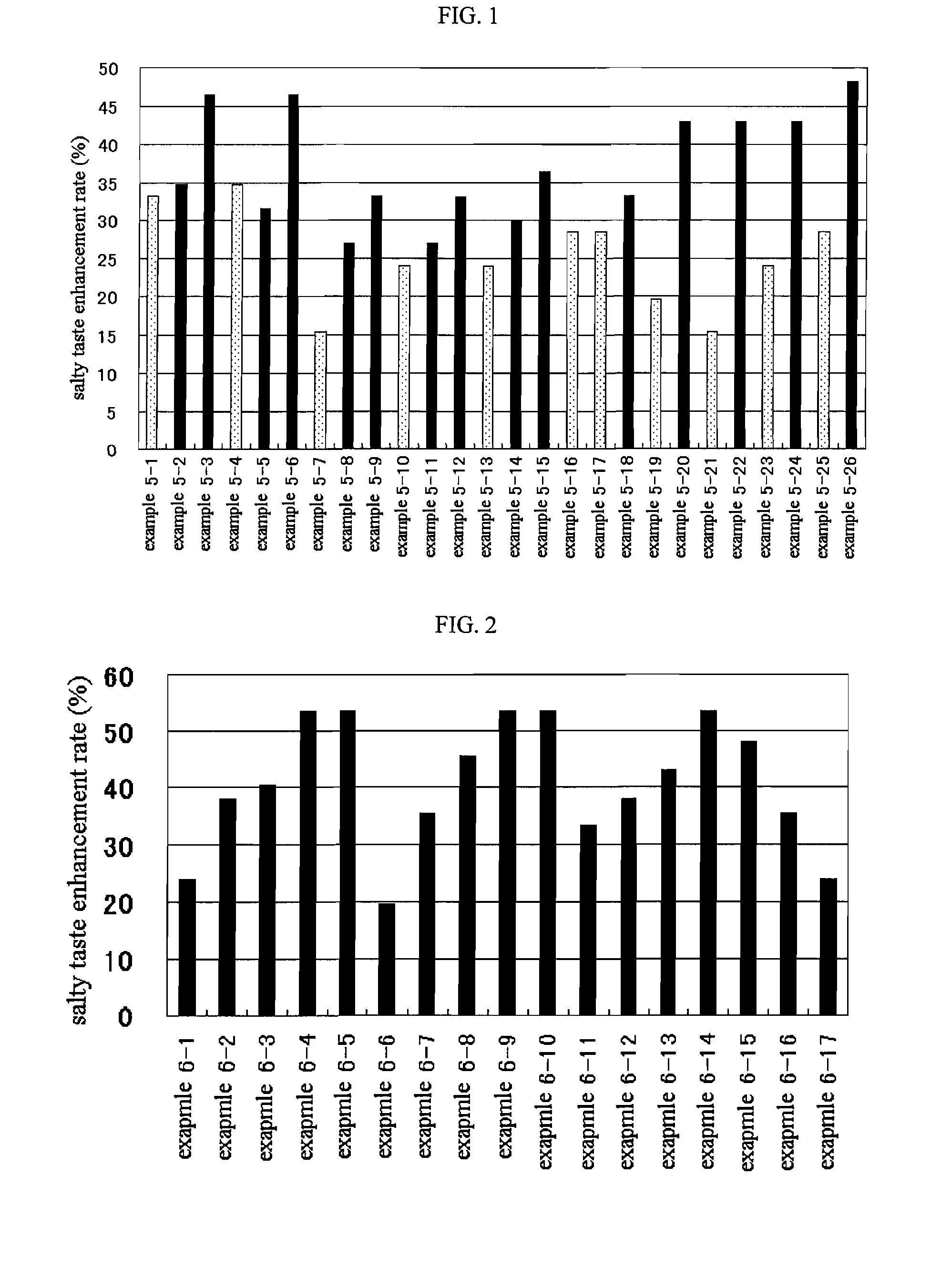Salty taste enhancer and food or drink containing same
- Summary
- Abstract
- Description
- Claims
- Application Information
AI Technical Summary
Benefits of technology
Problems solved by technology
Method used
Image
Examples
working example 1
Methods of Analysis
1. Measurement of Common Salt Content
[0053]Common salt content was measured according to the following method. A sample was diluted 25 times in 1% HCl and shaken for 30 minutes to extract sodium ions, the extracted sample was diluted in an arbitrary quantity of 1% HCl, and sodium content was measured using an atomic absorption photometer (Z-2000, manufactured by Hitachi High Technologies). The common salt content was calculated by multiplying the obtained sodium content by 2.54.
2. Measurement of Active Ingredient Content
[0054]The active ingredient content of the protein enzymatic decomposition products was determined by subtracting the common salt content from the Brix value of the protein enzymatic decomposition products. Moreover, the Brix value was measured using a Brix meter (PAL-1, manufactured by Atago Co., Ltd.).
3. Measurement of Salty Taste Enhancement Effect (Salty Taste Enhancement Rate)
[0055]The salty taste strength of a sample solution adjusted so that...
working example 2
Production of Enzymatic Decomposition Products of Animal Protein Materials
[0056]25.0 g of bonito broth extract (NP-40, produced by Nippon Suisan Kaisha, Ltd., crude protein content 40.0%), 11.3 g of powdered Alaskan pollock meat (produced by Nippon Suisan Kaisha, Ltd., crude protein content 88.8%), 10.8 g of casein (Sunlact S-3, produced by Taiyo Kagaku Co., Ltd., crude protein content 93.0%), 10.8 g of pork gelatin (AP-100, produced by Nitta Gelatin, Inc, crude protein content 93.0%) and 11.6 g of egg albumen (Egg Albumen K, produced by Kewpie Egg Corporation, crude protein content 86.5%) were each dispersed in distilled water, adjusted to a pH of 8.0 by means of 2N NaOH and made up to 100 g by adding water. 0.1 g of Sumiteam MP (produced by Shin Nihon Chemicals Corporation) was added to each of the reaction liquids and allowed to react for 24 hours at 50° C. Following the reaction, the enzyme was deactivated by heating for 30 minutes at 95° C., subjected to centrifugal separation ...
working example 3
Production of Enzymatic Decomposition Products of Plant Protein Materials
[0057]11.1 g of wheat gluten (A-Glu-G, produced by Glico Foods Co., Ltd., crude protein content 89.8%) and 10.7 g of soy protein isolate (Fujipro FX, produced by Fuji Oil Co., Ltd., crude protein content 93.6%) were each dispersed in distilled water, adjusted to a pH of 3.0 by means of 2N HCl and made up to 100 g by adding water. 0.1 g of Molsin F (produced by Kikkoman Corporation) and 0.1 g of Orientase 20A (produced by HBI) were added to each of the reaction liquids and allowed to react for 24 hours at 50° C. Following the reaction, the enzyme was deactivated by heating for 30 minutes at 95° C., subjected to centrifugal separation for 15 minutes at 7000 rpm (using a 50A-IV centrifugal separator manufactured by Sakuma) and filtration (using a No. 2 filter paper produced by Advantec) so as to obtain enzymatic decomposition products of plant protein materials. The corresponding working example number, Brix value...
PUM
 Login to View More
Login to View More Abstract
Description
Claims
Application Information
 Login to View More
Login to View More - R&D
- Intellectual Property
- Life Sciences
- Materials
- Tech Scout
- Unparalleled Data Quality
- Higher Quality Content
- 60% Fewer Hallucinations
Browse by: Latest US Patents, China's latest patents, Technical Efficacy Thesaurus, Application Domain, Technology Topic, Popular Technical Reports.
© 2025 PatSnap. All rights reserved.Legal|Privacy policy|Modern Slavery Act Transparency Statement|Sitemap|About US| Contact US: help@patsnap.com



